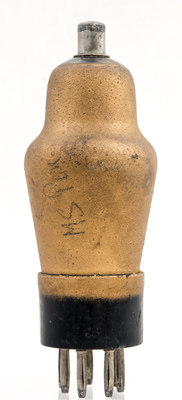This SP4 has a B7 base and an envelope shape that matches the 5 pin SP4. Most Mullard SP4s have the shape seen in SP4. This shape looks to match the one used by Cossor in the 210DDT and others. Did Cossor make this for Mullard?Mullard describe the SP4 as an indirectly heated HF pentode for use as a speech detector, or RF amplifier, in AC mains receivers. The heating time is given as 35 seconds.Equally important is its relatively thick heater (1 Amp rating) and improved heater-cathode insulation. Moreover, unlike the SG20, the heater-cathode insulation would never need to withstand high voltage.These differences made the SP4 a much more successful valve which was marketed in 5-pin SP4 or 7-pin base versions and is a relatively common valve in collections. Apart from its ungainly size, the main weakness of the SP4 was that it was unsuitable for AGC applications and therefore had no place in the 'modern' type of superhet which became the norm from the mid-1930s onwards, using the variable-mu pentode for RF and IF amplification. Alongside the SP4 in 1933 Mullard also launched the VP4 a variable-μ version for use in superhet designs with AGC or AVC as it was known then.
The reverse is plain screening paint.The balloon envelope is 44 mm in diameter and, excluding the B7 base pins, is 106 mm tall.References: Data-sheet, 1024 & 1043. Type SP4 was first introduced in 1933. See also 1933 adverts. |